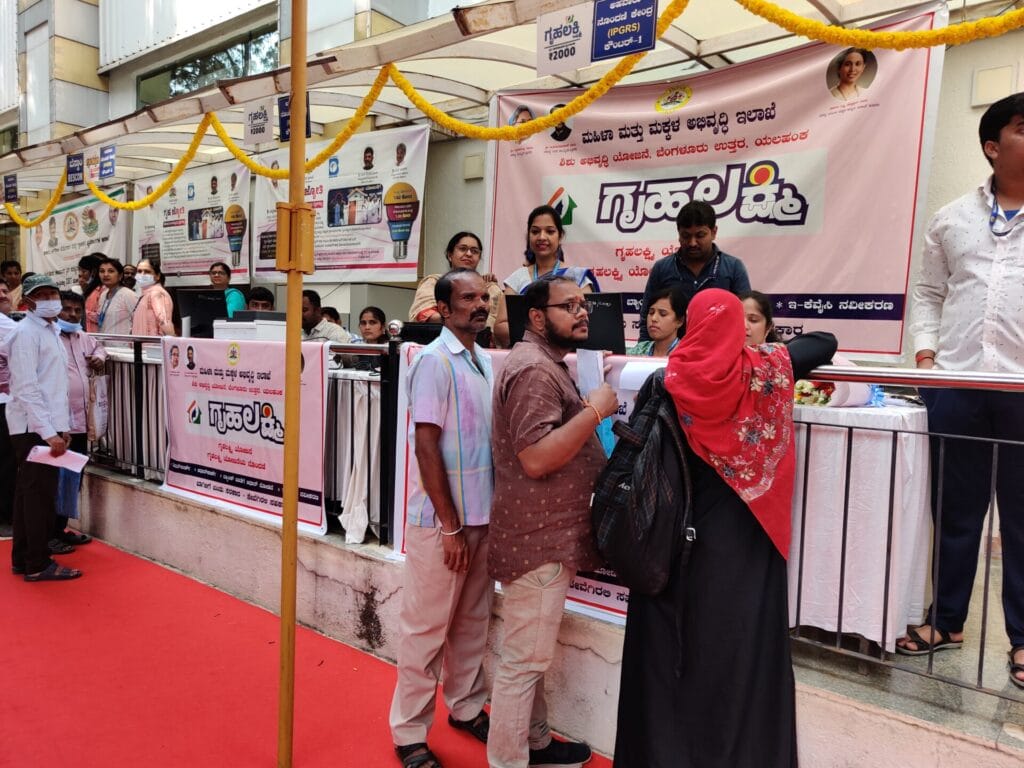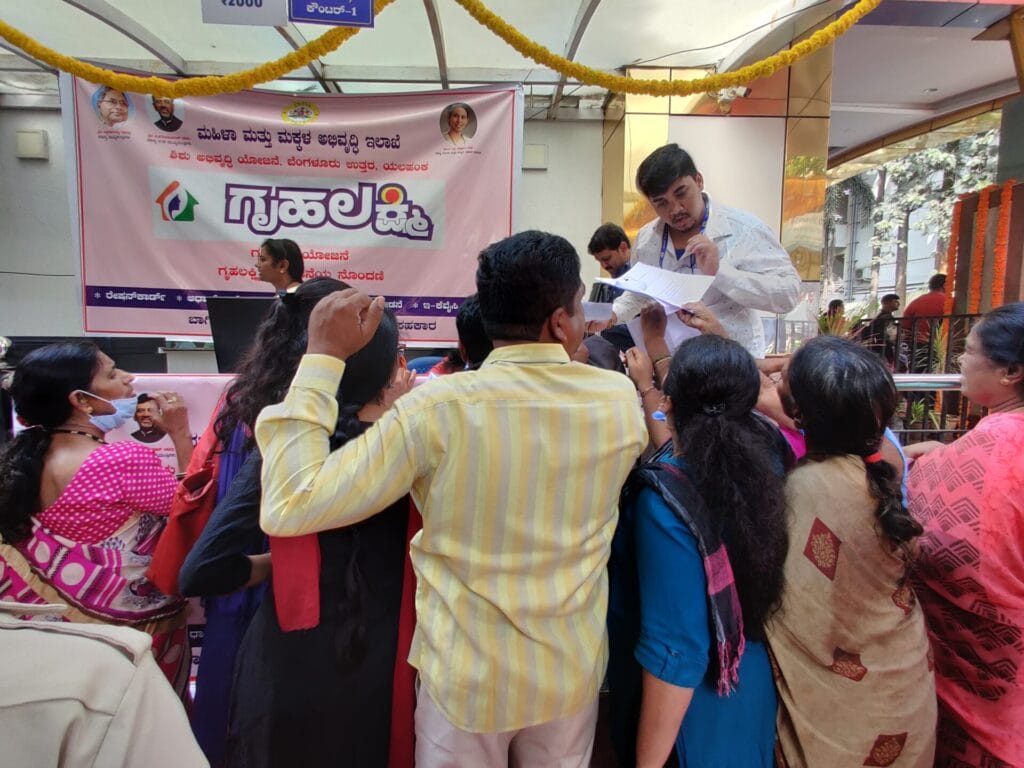The Gruha Lakshmi scheme was supposed to be the crowning glory of the Congress government’s five guarantees scheme. But for lakhs of women in the state, the scheme has not yet borne fruit. Under the policy, female heads of household in low-income families can receive Rs 2,000 per month to supplement their income. The scheme was formally launched in August last year, but several women had not yet received the benefits.
Who are eligible?
Women who are heads of their household and have a BPL (below poverty line), APL (above poverty line) or Antyodaya card issued by the Karnataka Department of Food and Civil Supplies are eligible to access the Gruha Lakshmi scheme.
Women who pay income tax or GST or have spouses who do so are not eligible. Female head of household can be self-declared, but only one woman from each house can apply. To receive the money, applicants must ensure that their bank account and ration card is linked with Aadhaar, according to the government order.
The scheme is being implemented by the Women and Child Welfare Department.
Read more: The promise of Gruha Lakshmi: Challenges of an ambitious scheme
Over 1.4 crore women have applied for the scheme. However, the Women and Child Welfare department said that over 10 lakh women did not receive payment since the scheme was launched in August. From the time of the launch, Gruha Lakshmi has been fraught with what the state government calls technical glitches.
Technical glitches
Preethi* is a domestic worker from Vidyaranyapura ward. She was relieved to find that the Gruha Jyothi or free electricity scheme and the Anna Bhagya scheme worked fine for her. She began receiving cash payments in lieu of grains under the Anna Bhagya scheme smoothly. But despite applying for the Gruha Lakshmi scheme promptly in June last year, she is yet to receive any funds.
“I got a message that I was registered, but no amount has been credited in my account,” she says. After numerous visits to her bank and the nearby Bangalore One Centre, she was told to go to the Food and Civil Supplies Department office in Yelahanka, where officials told her to update her ration card. The BPL card she held did not list her as head of the household.
The government order for the scheme passed in May last year clearly states that applicants can self-declare their head of household status. However, when applications were rolled out for the scheme, there was confusion over the head of the household status. Media outlets reported that only women who were listed as head or yajamani in their ration cards were eligible.
Read more: Shortfall in cash transfers: Anna Bhagya fails to reach all beneficiaries
Head of the household
Thus, women were being rejected for the scheme if their ration cards listed their spouse or other male relatives as head of household. The Women and Child Welfare Department dismissed the concerns. And the Food and Civil Supplies department claimed that over 90% of ration cards already listed women as head of household. In the rare cases where men were listed as heads, the department said applicants could approach the department to update the status. Preethi’s BPL card, issued over a decade ago, is in her husband’s name.

She is frustrated that this issue was not clarified in June, when she presented her card as part of the application. “I have missed out on five to six months of funds because of this,” she frets. Every penny counts as she and her husband have to support their four children with a combined monthly income of Rs. 22,000. She has now applied to update her card in December and is waiting to see if the funds will be released this January. She has, however, been told that she can’t get any arrears.
Lack of clarity
Meanwhile, Mariamma, a pourakarmika working in the same ward, is struggling with her own application. Like Preethi, she is successfully receiving the cash transfer of Rs. 500 under the Anna Bhagya scheme but is not receiving the amount under the Gruha Jyothi scheme. Unlike Preethi, her ration card clearly shows her listed as the head of the house.
Her bank passbook is updated to December and her bank account clearly linked to Aadhaar, which is why she is receiving the cash benefits under the Anna Bhagya scheme. Like Preethi, she approached the local Food office for clarity. “They could not find anything wrong. They just told me to go back to my bank and check my Aadhaar status. But I am getting ration [Anna Bhagya] funds in the same account. So, how can it be a bank issue?”
She is one of over 26 lakh women who did not receive Gruha Jyothi funds despite being eligible and having submitted all the documents. For months, whenever questioned on the funds not reaching all beneficiaries, the Women and Child Welfare Department minister, officials and even Chief Minister Siddaramaiah have stated that the gaps were due to technical issues.

Application issues
I spoke to an official from Women and Child Welfare department at the Janaspandana event in Yelahanka on December 5th. Janaspandana is a state government initiative to have a one-day long grievance redressal event for batches of Assembly Constituencies. It brings together major government departments, MLAs, and in this case, the deputy Chief minister and Bengaluru Development Minister DK Shivakumar. Major government departments, such as BBMP, BMTC, Revenue, hold counters and try to resolve people’s issues.
At the Gruha Lakshmi counter, several women and even a few male relatives queued up with one question: Why hadn’t they received the promised Rs 2,000? According to officials present, most issues were linked to the applications. Differences in the application form and the supporting documents, such as names being spelt differently caused confusion and led to applications being rejected, according to Women and Child Development officials. Aadhaar and bank linking was another issue and in some cases, applicants had not finished their eKYC or linking their Aadhaar and ration cards.
However, some women at the Janaspandana were perplexed because they had received funds for the first two months, August and September, but weren’t receiving it anymore. The officials at the Janaspandana declined to answer questions related to these queries. The women were given a note and asked to head to their Taluk office, where they were assured the problem would be solved.
However, the media reported that glitches also arose because the State Government had a cap over the number of payments that could be done in a day. Nodal officers were also confused about the fund release process, according to reports in October.
Bizarrely, in November 2023, the government declared that the Chamundeshwari deity in Mysuru would be registered under the scheme and receive Rs 2,000 per month. It is not clear if there were any glitches in the goddess’ application!
Not receiving Gruha Lakshmi benefits?
Some things that applicants can check to ensure they receive the benefits: 1) Check that your bank account and Aadhaar is linked. A retired official from Canara Bank has advised that applicants should ask their bank managers for a letter attesting that their account is linked to Aadhaar and submit it to the relevant department. He also advised that the beneficiaries check that the Aadhaar number linked to the bank account and the Aadhaar number provided in the Gruha Lakshmi database is the same.
2) Applicants should ensure that eKYC is updated for ration cards. You can apply to update your Aadhaar at the local Food Office and check the status here. You can also contact your local food inspector for more assistance here. If you or someone you know is having problems with the Gruha Lakshmi scheme, do write to us at bengaluru@citizenmatters.in or comment below.
*name changed